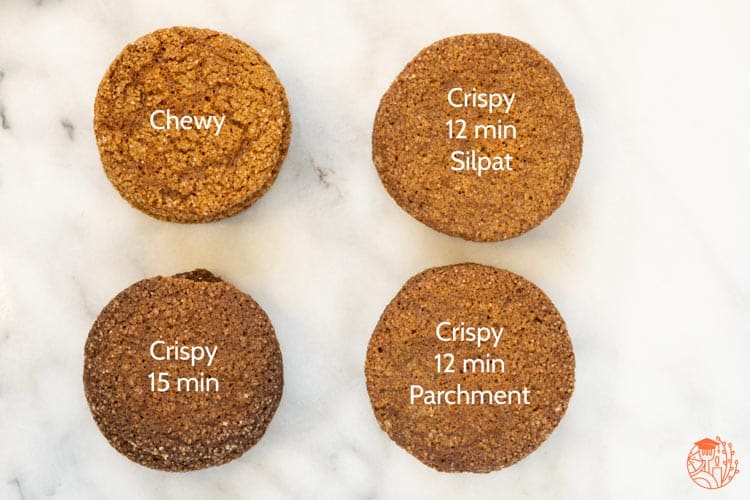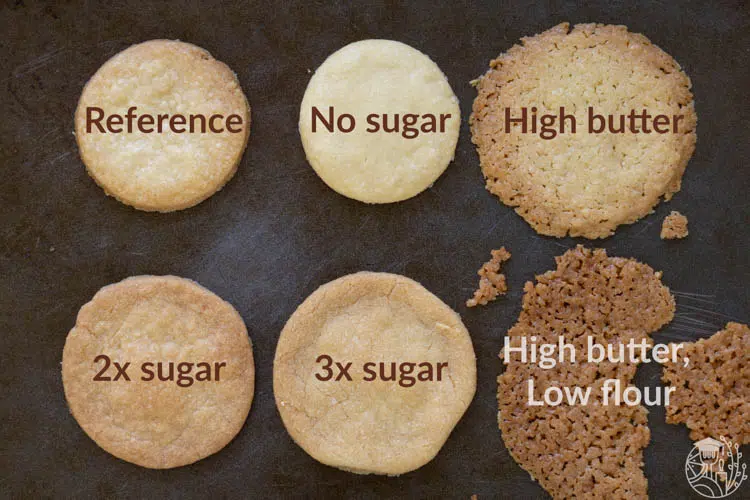Learn the science behind:

Unpeeling The Science of Cookies
Do you like your cookies crispy or chewy? With chocolate chips or maybe pieces of fruit? Do you like to decorate your cookies for the holidays? Do you enjoy making something special or do you prefer making a base recipe time and time again? Want to use butter or oil? Want your cookies sweet or maybe even a little salty?
No matter what cookie person you are, understanding the science of cookies is going to help you in your cookie-eating & baking game!
There are probably about as many cookie recipes out there as there are cookie eaters. Everyone has their own preference and types they prefer. It is impossible to test and explore every single cookie recipe. But, once you understand how a basic cookie recipe works, you can tweak it whichever way you like and make your own “perfect” version!
Here we’re collecting all the information (and updating it as we add more articles and useful references) to serve as your guide to the cookie baking universe!
Choosing a cookie
There are way too many cookie types and styles and recipes to even try naming them all. We’ve covered just a sliver of all that’s out there in the cookie universe. Learn, be inspired and hopefully learn something new.

Not your typical cookie since it’s fried instead of baked. But a cookie nevertheless, one with a ton of flavor, thanks to the ginger sugar coating.

Most cookies are soft when they come out of the oven. Some are so flexible yet strong, allowing you to bend the cookies! That’s what you can do to these almond tuiles.

Pepernoten (Dutch spiced cookies)
Americans have pumpkin spice, we Dutch have ‘speculaas’ spice. It’s not that different from pumpkin spice and a popular fall/winter spice mix. Pepernoten are just one of many cookies that use the spice mix.

A red velvet cookie isn’t what it might seem to be. Red velvet products contain cocoa and it’s actually quite the challenge to decide to color something brown bright red. It sure would have been easier without the cocoa in there!
Ingredients
Now that you’ve chosen your cookie type, you will want to know how to choose and use the required ingredients. Once you understand how they behave, you’ll be able to improve your cookie on the fly!

Impact of butter, flour & sugar
Probably the most common ingredients in cookies are butter, flour, and sugar. With a few simple experiments, we show you their role in cookies.
Sugar adds sweetness, crispness and crinkliness. Butter adds richness and smoothness, but too much will ‘break’ the cookie. Flour binds it all together and adds cohesiveness.

Starch, whether it’s from potatoes or corn, can help you achieve that sandy cookie texture you might be looking for. Use too much though and the cookie will be too soft and break when you try to pick it up.

You can use either cocoa powder or actual chocolate to give your cookie that chocolate flavor. When it comes to choosing cocoa powder, there are two main categories to choose from: Dutch-process (or alkalized) and natural. They differ in how they react with the other ingredients in your cookie.
However, there’s more. There’s a surprising high variability in fat content of cocoa powders and, cocoa powder from different origins may taste differently. How important this is for your cookie will depend on the quantity of cocoa in there!

OREO’s
One of the world’s most popular cookies: the OREO. Of course, it’s a feat of marketing, but those product developers definitely did something right as well.
Wondering why OREO’s are black? It’s the cocoa!

Who says you can’t modify the ingredients you’re starting with? A great and simple trick to amp up the flavor is to use browned butter.
Making the Cookie
How you mix the ingredients to form your cookie dough can be simple: just mix it all together, or consist of a few steps with a very precise order. Generally speaking, it’s best to follow the instructions in the recipe (especially the first time you’re making it, feel free to start tweaking after!).
In some cases, you’ll be asked to cream butter and sugar. This helps to incorporate tiny air bubbles in your cookies, making them just a little lighter.
Temperature control
Not every recipe is sensitive to it, but some recipes are: the temperature of the ingredients. This is especially true when making a recipe with a solid fat such as butter. Whether that fat is liquid or solid before the cookie goes into the oven can make a big impact. A liquid fat makes a thinner dough, that maybe splits more easily or spreads more. A solid fat does the opposite.

The oven is where the magic happens, where you’re carefully constructed and thought-out cookie dough gets transformed into an actual cookie!
A lot of things happen at the same time, fats melt, the Maillard reaction causes browning, leavening agents cause expansion, starch gelatinizes and more.

Baking cookies in the oven might be one of the more common ways to heat a cookie, it sure isn’t the only one. The kurma we discussed above is fried in oil for that perfect crisp.
You can also cook the cookie on a grill, making it a barbecookie! Grilling does make temperature control a lot more challenging, but does increase the fun factor as well!

Once the cookies have been baked, it’s time for them to cool back down to room temperature. For some cookies you want this to happen fast (especially if you think you might have just overbaked them), for others, the rate at which you do this doesn’t matter at all.
Decorating
Looking to decorate your cookie? Choose your cookie and decoration type (icing?) wisely to get the results you’re looking for.
Choosing a cookie type
In theory, you can decorate every cookie you want. But, if you are planning on making more intricate, detailed designs, as opposed to just a few swirls, your cookie will have to meet several requirements:
- Have a flat surface: for optimal decoration results, a flat surface works best. This will make it easier to make a detailed drawing on the cookie surface. You get a flat surface by using little leavening agent and by using a cookie dough that can be rolled out flat.
- Be sufficiently dry: a very moist cookie isn’t suitable for decoration. This has to do with moisture migration. Icing has a pretty low water activity due to the high sugar content. This is becomes even lower over time since part of the moisture will evaporate concentrating the sugar even further. If a cookie on the other hand is very moist, some water might migrate into the icing. This will make it wetter and thus harder to set properly.
- Not be too sweet: icing is sweet, so if your cookie is already very sweet, it will make it even sweeter, better to have a less sweet base, although tastes can differ of course!
When choosing a cookie, be original. You will see that almost all of the cookie decorators use the same type of pretty plain standard cookies to decorate such as shortbread or gingerbread.
Choosing an Icing
Are you into decorating your cookies? We by no means are cookie decorating experts, it’s a skills you develop by doing. But, we do enjoy analyzing icings and techniques, to help you decoration-pros become even better!

This is probably the simplest icing there is to decorate your cookies. All you need is some powdered sugar and water and you’re ready to get going (and cookies of course!).

This icing is a little more complex to make, but it still only requires three ingredients. The addition of egg white powder helps to thicken this icing and gives you a lot of control over its flow properties.

Not sure which one to choose? Or not sure what the difference between the two is? Join us for a deep dive into the science behind these two icings!
Applying & Drying
Once you’ve got your cookie and icing, it’s time to decorate. But, not so fast, first, make sure your cookies have cooled down! A hot cookie will result in a runny, more liquid icing. If you have perfected your icing consistency, it’s best that the cookie is about the same temperature as the icing, just to be sure.
Once the icing has been applied it will start drying immediately. As long as the icing is in a vessel, bowl or bag, it won’t dry out too much. The surface area is quite small compared to the overall volume. However, once you’ve applied the icing, the surface area will be a lot larger. This makes it a lot easier for the moisture to escape from the icing. As a result, the icing will thicken and harden out.
Drying icing at a large scale
When you decorate cookies at home drying the cookie is a matter of patience. You make sure the cookies don’t touch each other and you’re fine. However, imagine drying far larger quantities. If you’re got several hundred cookies it becomes a matter of stacking them smartly and maybe helping the drying along with a fan to wave off moisture.
If you have thousands though, things become more complicated. The cookies will not dry quick enough at room temperature and thus extra heating is used. However, you don’t want the icing to crack so generally the maximum drying temperature is 80C. Above this temperature, moisture evaporation goes too fast and might create bubbles and other inconsistencies.
Further Learning
Still not done learning? Luckily, we’ve got plenty of other tips to keep you busy for some time to come ;-).

We enjoy reading about cookies as well :-)! Here we’ve gathered some of our favorite websites and articles.

Are you into drop cookies (cookies that you scoop or form into a ball before baking?) such as chocolate chip cookies or gingersnaps? Then we’d recommend this book by Tessa Arias (from handletheheat.com), it’s full of cookie science explanations and a range of recipes to get going!

Don’t get this book if all you’re after is learning more about cookies. Cookies make up just a small sub-section of this book. That said, they do some nice tests, such as testing different types of baking sheets and they have a good section explaining the role of sugar in cookies (no, it’s not just for sweetness).
By using the affiliate link FoodCrumbles will get a commission on the sale, without impacting the price you pay.

Anyone can do food (or cookie!) science at home. Just change one or two variables between a few batches and compare the results. It probably won’t be a challenge to find taste testers…
References
Sweet sugar belle, on the use of a fan to dry your icing, link
Sally’s baking addiction, on decorating cookies with icing, link
Biscuit, cookie and cracker manufacturing, Manual 5, Secondary processing in biscuit manufacturing, chapter 7, link
Biscuit, cracker and cookie recipes for the food industry, Duncan Manley, 2001, chapter 10.3, link
What's your challenge?
Struggling with your food product or production process? Not sure where to start and what to do? Or are you struggling to find and maintain the right expertise and knowledge in your food business?
That's where I might be able to help. Fill out a quick form to request a 30 minute discovery call so we can discuss your challenges. By the end, you'll know if, and how I might be able to help.




